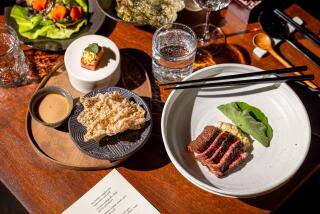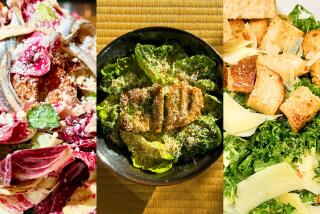A Goddess Worth Worshiping
- Share via
It was definitely a weird combination of setting and theme, but there I was, sitting in a fancy French restaurant in New York City, and all I could think about was Green Goddess salad dressing.
The restaurant was Picholine, which is vaguely Provencal, but mainly very, very good (you have to love a restaurant that has a cheese trolley). The dish was a warm salad of asparagus and avocado loosely bound with a very suave mayonnaise.
It was delicious, but I couldn’t help thinking it would have been better with a little West Coast help. And Green Goddess, though it is scorned now because of its association with that vast muck of bottled salad dressings, is one of the finest inventions of California cuisine.
Of course, that’s not California cuisine of the Wolfgang Puck / Alice Waters sort, but rather from a much earlier vintage. True California foodies know that Green Goddess salad dressing was invented during the 1920s at San Francisco’s Palace Hotel. It was named after a play that was then popular.
Unfortunately, that bit of history is probably better known than the dressing itself. That’s a real shame, because Green Goddess--and we’re talking real Green Goddess here, not some ready-made substitute--is a truly wonderful thing.
It’s as if the best parts of a California spring have been distilled into a rich creamy sauce. Tangy with anchovies and heady with fresh herbs, with an appealing high note of tarragon soaring above it all, Green Goddess is the glue that will hold together any number of composed salads. (There are also dressings called Green Goddess that don’t have tarragon--including one in the current “Joy of Cooking”--but they are an historical abberation.)
Yes, I said composed salads--combinations of cold meat, fish or vegetables. Being mayonnaise-based, Green Goddess is far too heavy to use on regular green salads, particularly today’s fragile, fashionable mesclun-type mixes.
Unfortunately, composed salads are a bit under a cloud today. They begat the kind of warm duck salad that Claude Segal and others popularized in the ‘80s, but they also led to the pedestrian chicken, turkey and tuna salads sold at every lunch counter.
The elaborate mayonnaise-based composed salads of the old school are dishes you don’t see that often anymore. “The fish and meat salads, with the heavier mayonnaise, are suitable for luncheon, supper, high tea and those Bohemian feasts which begin at the mystic hour of midnight,” wrote the unfortunately named Olive Green in a 1909 book “One Thousand Salads.” Lord knows what today’s new bohos are eating at midnight, but it’s a safe bet it’s not Green Goddess.
Making Green Goddess dressing is no problem at all. Puree anchovies, herbs and mayonnaise in a blender or food processor. If you want an especially authentic version, grinding them in a mortar with a pestle will give you a somewhat coarser texture that is very nice.
It’s hard to give exact amounts for the ingredients because herbs vary in intensity depending on the time of year and how they’re grown, and some mayonnaises are richer than others (I prefer Best Foods, which in a blind taste test I picked over my own homemade). Taste as you go along. The most important thing is to make sure you mix in enough tarragon--that is the real hallmark of a great Green Goddess.
Prescribing ingredients for the salad itself is similarly difficult. In fact, it is almost beside the point. The real magic of a composed salad is how you can take the prosaic everyday things you probably have languishing in your refrigerator--a little roasted chicken and some green beans, some poached fish and boiled potatoes--and turn them into something that tastes pretty spectacular.
I happen to think that this combination--the avocado and asparagus from Picholine sweetened with some cooked shrimp--is about as good as you can get. But that’s this week. Next week the story might be different. Ingredients change. Only the Goddess remains the same.
GREEN GODDESS SALAD
1 1/2 cups mayonnaise
4 anchovy filets
2 green onions, green parts only
1 1/2 tablespoons chopped parsley
2 tablespoons chopped tarragon
2 tablespoons tarragon vinegar
2 tablespoons minced chives
2 avocados
1 pound peeled, deveined shrimp
3/4 pound asparagus
Roughly puree mayonnaise, anchovies, green onions, parsley, tarragon, vinegar and chives in food processor or blender, or grind in mortar with pestle.
Cut avocados away from pit in lengthwise wedges. Peel and cut into large cubes.
Cook shrimp in boiling water just until firm, 3 to 4 minutes. Drain.
Trim woody bases of asparagus and, if bigger around than a pencil, peel ends. Lay spears flat in broad pan. Add 1 cup water, cover and bring rapidly to boil. Cook over high heat, shaking pan occasionally to turn asparagus, until spears are bright green and beginning to soften, about 4 minutes. Drain and cut into 2-inch sections.
Combine avocados, shrimp and asparagus in large bowl. Add half of flavored mayonnaise and toss gently to coat. Add just enough mayonnaise to loosely bind ingredients.
Divide in loose mounds among 6 plates.
6 servings. Each serving:
303 calories; 345 mg sodium; 92 mg cholesterol; 20 grams fat; 19 grams carbohydrates; 16 grams protein; 2.66 grams fiber.
*
In photo at left, Karen Lee Ballard napkin from Bristol Kitchens, South Pasadena and Pottery Shack, Laguna Beach. Dalzell Viking plate from Silver Skillet, Del Mar.
More to Read
Eat your way across L.A.
Get our weekly Tasting Notes newsletter for reviews, news and more.
You may occasionally receive promotional content from the Los Angeles Times.











